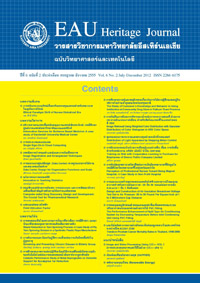การลดของเสียในกระบวนการปั่นเกลียวเชือก กรณีศึกษา แผนกปั่นเกลียวของอุตสาหกรรมผลิตเชือกพลาสติก
คำสำคัญ:
การลดของเสีย, กระบวนการปั่นเกลียวเชือก, อุตสาหกรรมผลิตเชือกพลาสติก, waste reduction, yarn spinning process, synthetic plastic rope manufacturerบทคัดย่อ
งานวิจัยนี้มีวัตถุประสงค์เพื่อลดของเสียที่เกิดจากกระบวนการปั่นเกลียวเชือกด้วยเครื่องปั่นเกลียว เครื่องที่ B27 B28 และ B29 ที่มีปริมาณของเสียสูงกว่าเกณฑ์ที่โรงงานยอมรับได้ (ร้อยละ 7) ซึ่งของเสียที่เกิดขึ้นมี 4 ลักษณะ ได้แก่ ด้ายเป็นขุย เศษด้ายที่เหลือติดค้างที่แกนหลอด ด้ายพันกัน และเศษด้ายที่เกิดจากการมัด ตัด ต่อ ด้าย ในขั้นตอน การหาสาเหตุการเกิดของเสีย ได้ประยุกต์ใช้การระดมสมอง หลักการสุ่มงาน แผนภูมิเหตุและผล และแผนภูมิพาเรโต ในการวิเคราะห์ พบว่า สาเหตุเกิดจากพนักงานขาดทักษะและความชำนาญงาน ทำงานไม่เป็นทีม ไม่มีวิธีการทำงาน ที่เป็นมาตรฐาน เครื่องจักรและชิ้นส่วนอะไหล่ภายในตัวเครื่องมีสภาพเก่า สึกหรอ และชำรุด ในขั้นตอนการลดของเสียได้ ประยุกต์ใช้หลักการศึกษาการทำงาน เพื่อปรับปรุงขั้นตอนและวิธีการทำงาน ใช้วิธีการอบรม จัดทำคู่มือการปฏิบัติงาน การบำรุงรักษาด้วยตนเอง และกิจกรรม 5ส ผลที่ได้จากขั้นตอนการลดของเสียส่งผลให้ปริมาณของเสียของเครื่องจักร เครื่องที่ 27 ลดลงจากร้อยละ 7.04 เหลือร้อยละ 5.12 เครื่องจักรที่ 28 ลดลงจากร้อยละ 6.97 เหลือร้อยละ 4.48 และเครื่องจักรที่ 29 ลดลงจากร้อยละ 7.12 เหลือร้อยละ 6.05 ซึ่งอยู่ในเกณฑ์ที่โรงงานยอมรับได้
Waste Reduction in Yarn Spinning Process: A Case Study of Ply Yarn Spinning Division in a Synthetic Plastic Rope Manufacturer
The objective of this project is to reduce the waste of three ply yarn spinning machines: machine numbers B27, B28 and B29, in a yarn spinning process. Overall amount of their waste production was over a maximum acceptance limit for this process (7%). Based on data collection, there are four effects of quality problems: yarn is not smooth, some residual yarn left at an axle, skein, and some residual yarn left from connecting or cutting. In root cause defect analysis, several industrial engineering techniques including brain storming, work sampling, cause-effect diagram, and Pareto diagram are applied. The findings pointed that the root causes are the lack of skills and experience of workers, workers do not work as a team, no working standard, and machines and their parts in an old, wear, and breakdown manners. In reducing waste of these machines, several industrial engineering techniques, including work study, training, autonomous maintenance, and 5S activities are applied again. The result obtained after implementing all these techniques is that the amounts of waste from machine numbers B27, B28 and B29 decreases from 7.04, 6.97, and 7.12% to 5.12, 4.48, and 6.05% respectively.







